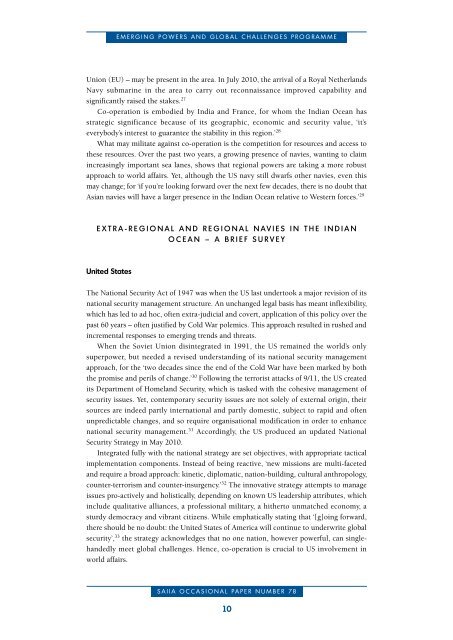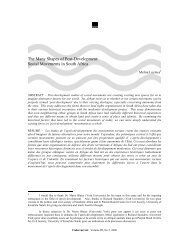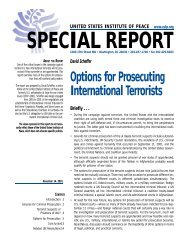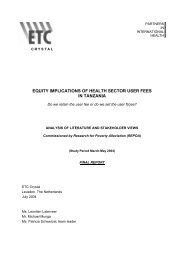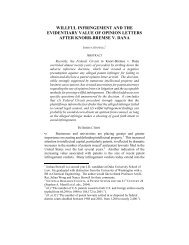Africa and the Geopolitics of the Indian Ocean
Africa and the Geopolitics of the Indian Ocean
Africa and the Geopolitics of the Indian Ocean
Create successful ePaper yourself
Turn your PDF publications into a flip-book with our unique Google optimized e-Paper software.
EMERgINg POwERS ANd gLOBAL ChALLENgES PROgRAMME<br />
Union (EU) – may be present in <strong>the</strong> area. In July 2010, <strong>the</strong> arrival <strong>of</strong> a Royal Ne<strong>the</strong>rl<strong>and</strong>s<br />
Navy submarine in <strong>the</strong> area to carry out reconnaissance improved capability <strong>and</strong><br />
significantly raised <strong>the</strong> stakes. 27<br />
Co-operation is embodied by India <strong>and</strong> France, for whom <strong>the</strong> <strong>Indian</strong> <strong>Ocean</strong> has<br />
strategic significance because <strong>of</strong> its geographic, economic <strong>and</strong> security value, ‘it’s<br />
everybody’s interest to guarantee <strong>the</strong> stability in this region.’ 28<br />
What may militate against co-operation is <strong>the</strong> competition for resources <strong>and</strong> access to<br />
<strong>the</strong>se resources. Over <strong>the</strong> past two years, a growing presence <strong>of</strong> navies, wanting to claim<br />
increasingly important sea lanes, shows that regional powers are taking a more robust<br />
approach to world affairs. Yet, although <strong>the</strong> US navy still dwarfs o<strong>the</strong>r navies, even this<br />
may change; for ‘if you’re looking forward over <strong>the</strong> next few decades, <strong>the</strong>re is no doubt that<br />
Asian navies will have a larger presence in <strong>the</strong> <strong>Indian</strong> <strong>Ocean</strong> relative to Western forces.’ 29<br />
E x t R A - R E G I o N A l A N d R E G I o N A l N A v I E S I N t h E I N d I A N<br />
oCEAN – A bRIEf SuRvEy<br />
United States<br />
The National Security Act <strong>of</strong> 1947 was when <strong>the</strong> US last undertook a major revision <strong>of</strong> its<br />
national security management structure. An unchanged legal basis has meant inflexibility,<br />
which has led to ad hoc, <strong>of</strong>ten extra-judicial <strong>and</strong> covert, application <strong>of</strong> this policy over <strong>the</strong><br />
past 60 years – <strong>of</strong>ten justified by Cold War polemics. This approach resulted in rushed <strong>and</strong><br />
incremental responses to emerging trends <strong>and</strong> threats.<br />
When <strong>the</strong> Soviet Union disintegrated in 1991, <strong>the</strong> US remained <strong>the</strong> world’s only<br />
superpower, but needed a revised underst<strong>and</strong>ing <strong>of</strong> its national security management<br />
approach, for <strong>the</strong> ‘two decades since <strong>the</strong> end <strong>of</strong> <strong>the</strong> Cold War have been marked by both<br />
<strong>the</strong> promise <strong>and</strong> perils <strong>of</strong> change.’ 30 Following <strong>the</strong> terrorist attacks <strong>of</strong> 9/11, <strong>the</strong> US created<br />
its Department <strong>of</strong> Homel<strong>and</strong> Security, which is tasked with <strong>the</strong> cohesive management <strong>of</strong><br />
security issues. Yet, contemporary security issues are not solely <strong>of</strong> external origin, <strong>the</strong>ir<br />
sources are indeed partly international <strong>and</strong> partly domestic, subject to rapid <strong>and</strong> <strong>of</strong>ten<br />
unpredictable changes, <strong>and</strong> so require organisational modification in order to enhance<br />
national security management. 31 Accordingly, <strong>the</strong> US produced an updated National<br />
Security Strategy in May 2010.<br />
Integrated fully with <strong>the</strong> national strategy are set objectives, with appropriate tactical<br />
implementation components. Instead <strong>of</strong> being reactive, ‘new missions are multi-faceted<br />
<strong>and</strong> require a broad approach: kinetic, diplomatic, nation-building, cultural anthropology,<br />
counter-terrorism <strong>and</strong> counter-insurgency.’ 32 The innovative strategy attempts to manage<br />
issues pro-actively <strong>and</strong> holistically, depending on known US leadership attributes, which<br />
include qualitative alliances, a pr<strong>of</strong>essional military, a hi<strong>the</strong>rto unmatched economy, a<br />
sturdy democracy <strong>and</strong> vibrant citizens. While emphatically stating that ‘[g]oing forward,<br />
<strong>the</strong>re should be no doubt: <strong>the</strong> United States <strong>of</strong> America will continue to underwrite global<br />
security’, 33 <strong>the</strong> strategy acknowledges that no one nation, however powerful, can singleh<strong>and</strong>edly<br />
meet global challenges. Hence, co-operation is crucial to US involvement in<br />
world affairs.<br />
SAIIA OCCASIONAL PAPER NUMBER 78<br />
10


